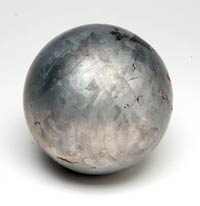Wall thickness
The hollow metal ball has an outside diameter of 40 cm. Determine the wall thickness if the weight is 25 kg and the metal density is 8.45 g/cm3.
Final Answer:

Tips for related online calculators
Do you know the volume and unit volume, and want to convert volume units?
Tip: Our Density units converter will help you convert density units.
Do you want to convert mass units?
Tip: Our Density units converter will help you convert density units.
Do you want to convert mass units?
You need to know the following knowledge to solve this word math problem:
algebraarithmeticsolid geometryUnits of physical quantitiesGrade of the word problem
We encourage you to watch this tutorial video on this math problem: video1
Related math problems and questions:
- Brass ball
 What is the weight of a hollow brass ball, the outer diameter of which is 16 cm and the wall thickness is 2 cm, while the density of brass is ϱ = 8.5 g
What is the weight of a hollow brass ball, the outer diameter of which is 16 cm and the wall thickness is 2 cm, while the density of brass is ϱ = 8.5 g - Hollow sphere
 Calculate the weight of a hollow dural sphere (density 2.75 g/cm³) if the inner diameter is 18 cm and the wall thickness is 3 mm.
Calculate the weight of a hollow dural sphere (density 2.75 g/cm³) if the inner diameter is 18 cm and the wall thickness is 3 mm. - Determine 10561
 The hollow nickel ball has an outer diameter of 0.4 meters and an inner diameter of 0.3 meters. If the nickel density is 9000 kg/m3, determine its weight.
The hollow nickel ball has an outer diameter of 0.4 meters and an inner diameter of 0.3 meters. If the nickel density is 9000 kg/m3, determine its weight. - Calculate 8891
 Calculate the weight of a PVC pipe with an inner diameter d = 45 mm and a length l = 3 m if the wall thickness of the pipe is s = 7.5 mm. The density of PVC is ρ = 1350 kg/m³.
Calculate the weight of a PVC pipe with an inner diameter d = 45 mm and a length l = 3 m if the wall thickness of the pipe is s = 7.5 mm. The density of PVC is ρ = 1350 kg/m³. - Hollow sphere
 The hollow steel sphere floats on the water, plunged into half its volume. Determine the outer radius of the sphere and wall thickness if you know that the weight of the sphere is 0.5 kg and the density of steel is 7850 kg/m³
The hollow steel sphere floats on the water, plunged into half its volume. Determine the outer radius of the sphere and wall thickness if you know that the weight of the sphere is 0.5 kg and the density of steel is 7850 kg/m³ - Brass sphere
 Find the weight of a brass ball with an outer radius of 12 cm and a wall thickness of 20 mm if the brass's density is 8.5 g/cm³.
Find the weight of a brass ball with an outer radius of 12 cm and a wall thickness of 20 mm if the brass's density is 8.5 g/cm³. - Concrete hatch
 The concrete hatch for a round well has a diameter of 1300 mm and a thickness of 80 mm. Determine its weight in kg if the density of the concrete is 2545 kg/m3
The concrete hatch for a round well has a diameter of 1300 mm and a thickness of 80 mm. Determine its weight in kg if the density of the concrete is 2545 kg/m3
